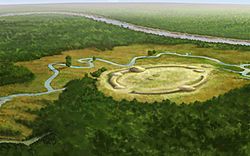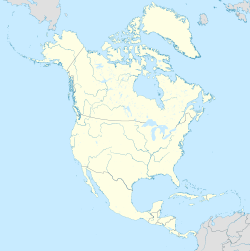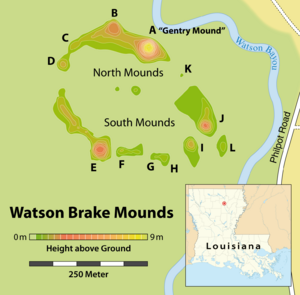Watson Brake facts for kids

Artist's conception of the Watson Brake Site
|
|
| Location | Logtown, Ouachita Parish, Louisiana, USA |
|---|---|
| Region | Ouachita Parish, Louisiana |
| Coordinates | 32°22′6.31″N 92°7′53.00″W / 32.3684194°N 92.1313889°W |
| History | |
| Founded | 3500 BCE |
| Cultures | Archaic period |
| Site notes | |
| Responsible body: private | |
Watson Brake is an amazing archaeological site in Ouachita Parish, Louisiana, in the United States. It dates back about 5,400 years ago, around 3500 BCE. This makes Watson Brake the oldest known mound complex in North America.
Imagine this: it's even older than the famous Egyptian pyramids or England’s Stonehenge! When it was discovered and dated in 1997, it completely changed what archaeologists thought about ancient cultures in the Southeast. It showed that these early people were much more organized and capable than previously believed. They could manage huge building projects over hundreds of years.
Before Watson Brake, experts thought the oldest earthworks were much newer. They also thought only settled farming groups built such large structures. But Watson Brake was built by people who were mostly hunter-gatherers, meaning they moved around to find food. This discovery proved that complex societies existed much earlier than expected.
The people who built Watson Brake created an oval shape with eleven earthwork mounds. These mounds range from about 3 to 25 feet (1 to 7.6 meters) tall. They are connected by ridges, forming an oval almost 900 feet (274 meters) across. The site is located near Watson Bayou, close to the Ouachita River in northern Louisiana.
Watson Brake is 1,900 years older than Poverty Point, another well-known mound site in Louisiana. Poverty Point was once thought to be the earliest mound site in North America. This shows that mound building in the Americas started a very long time ago.
The discovery of Watson Brake as a Middle Archaic site teaches us a lot. It shows that early indigenous cultures in what is now the United States were very advanced. Even without farming or pottery, they planned and organized large groups of people. These groups worked for centuries to build these impressive mounds and ridges. Building such large structures often shows that a society is becoming more complex.
How Watson Brake Was Found and Dated
In the early 1980s, a local person named Reca Bamburg Jones found this important site. She told professional archaeologists about it. By 1981, after some logging cleared the area, Jones saw the clear pattern. She noticed the eleven mounds connected by ridges, forming a complex about 280 yards (256 meters) wide. In 1983, Jones and John Belmont wrote about the site in a report on the history of the Ouachita River Valley. Around this time, Joe W. Saunders, a state archaeologist, also saw the site.
The land where Watson Brake is located has been privately owned since the 1950s. Today, several family members still own about half of the site. They have allowed archaeologists to study the area. However, the site is not open for public visits. In 1996, The Archaeological Conservancy bought half of the site. They later sold it to the state of Louisiana to help protect it.
Starting in the 1990s, a team from Northeast Louisiana University used radiocarbon dating to figure out the age of the site. This method helps scientists determine how old ancient materials are. The team, led by Joe W. Saunders, published their findings in the journal Science in 1997. Their work proved how incredibly old the mound complex was.
Scientists took 27 radiocarbon dates from the site. These dates showed that people first lived there around 4000 BCE. This was during the Middle Archaic period. The building of the mounds began around 3500 BCE and continued for about 500 years. During this time, the mounds were made larger in different stages. Digging at the site showed that there was enough time between building periods for people's trash (called "midden deposits") to pile up on top of the mounds and ridges. Other teams also dated the site using sand grains and natural acids in the soil.
The trash piles (middens) tell us that people might have used Watson Brake as a "base" from summer through fall. This means they were still moving around, but came back to this spot regularly. Saunders and his team think that the times when people built the mounds match periods of unusual rainfall. These changes were likely caused by El Niño-Southern Oscillation events. Building the mounds might have been a way for the community to deal with new challenges like droughts and floods, which made finding food harder.
The remains in the middens show that the people ate a lot of fish, shellfish, and animals from the river. They also ate local plants like goosefoot and knotweed. Over time, they started eating more land animals, such as deer, turkey, raccoons, and rabbits. This change probably happened because the environment and waterways around the site were changing. It seems the site was left empty around 2800 BCE. This might have happened because the main river channels and swamps near the site changed.
Watson Brake, along with other Middle Archaic sites in Louisiana and Florida, shows us something important. It proves that complex societies could develop even among hunter-gatherer groups. These people only lived at the site during certain seasons. Yet, they were able to plan and carry out huge building projects for hundreds of years.
Unlike Poverty Point, where people made tools from materials traded from far away places, the items found at Watson Brake were made from local materials. The stone points they used for hunting were from the Middle to Late Archaic period. They were made more simply than those found at Poverty Point. The people also heated local gravel to use as cooking stones for steaming their food. They made and fired clay items in different shapes, but experts are still trying to figure out what these items were used for.
Who Owns and Manages the Site?
Most of the Watson Brake site has been owned by eight members of the Gentry family since the 1950s. One family member has chosen not to sell their part of the property to the state. Because of this, the site is not open for the public to visit. However, the family has given special permission to individual archaeologists to do research there.





